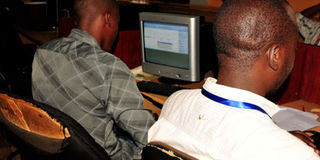Prolonged sitting: Why it is bad for your health

If your work involves sitting for long hours, it is recommended that you also take part in other activities, such as jogging and walking, in order to keep fit and healthy. photo by Michael Kakumirizi
What you need to know:
Below, Dr Alex Kakoraki, a general practitioner at Murchison Bay Hospital Luzira, and Dr Andrew Ssekitoleko, a family physician and director for medical services at International Hospital Kampala (IHK), share some of the effects of prolonged sitting and what can be done to deal with the problem
For many people, work involves sitting for long periods of time. And yet recent studies conducted around the world show this could be a risk factor for obesity and chronic diseases that are fast becoming the biggest concerns in public health.
Prolonged sitting can lead to complications such as damage of the cardiovascular and central nervous system, muscular and skeletal, respiratory and metabolism systems.
Below, Dr Alex Kakoraki, a general practitioner at Murchison Bay Hospital Luzira, and Dr Andrew Ssekitoleko, a family physician and director for medical services at International Hospital Kampala (IHK), share some of the effects of prolonged sitting and what can be done to deal with the problem.
Blood circulation
Dr Kakoraki says the effects of prolonged sitting on the heart are gradual, but can be fatal. He says the heart is active when one makes it active, and functions best when its muscles are exercised. “Being active is vital for the heart since it is the centre of everything and pumps oxygenated blood all over the body,” he says.
He adds that sitting over long periods of time leads to poor blood circulation and oxygen supply to the peripheral organs of the body.
This may, in turn, result in small clots of blood, which later lead to clogging of major vessels such as the cardiopulmonary vessels that supply blood to the lungs. This cuts off oxygen supply to other organs. It is such conditions that subsequently lead to strokes.
Dr Ssekitoleko adds that because of poor circulation, blood cannot move easily from the legs leading to swelling of the feet. Continuous sitting can in later years also result in permanent swelling of the legs, especially as one grows older.
Twisted vein condition
This is a condition where there is an increased engagement of blood veins, causing them to swell.
These swellings are common among people who sit or stand over long periods of time. Such people may have conditions that press vessels, preventing blood from moving back to the heart for oxygenation. These swellings are also common among pregnant women, especially in the second and third trimesters.
Symptoms of insufficient oxygen supply include headache, fever and general body weakness. Because many people are not aware of these symptoms, it may end up killing them, especially if it is associated with high levels of stress.
Central nervous system
When one sits for long, pressure is put on the nerve roots, leading to reduced movement of impulses.
“The bones sandwich the nerves causing needle prick-like sensation or numbness and this leads to injury to the nerves,” explains Dr Kakoraki.
He says it is the active muscles that pump fresh blood and oxygen to the brain with little or no body movement, everything slows down including brain activity. The nerves act as signals to different parts, therefore a negative effect on the nerves leads to affected muscles, bones, joints and ligaments.
Muscle pain
“Many muscles are involved during sitting posture, but these too have a limit and we cannot increase our capacity for sitting muscles,” adds Dr Ssekitoleko.
“When muscles are over-used, they hit their limit and use an alternate source of energy, leading to the production of lactic acid. Overtime, some of these muscles open up, causing one to experience pain.”
Change in back shape
Prolonged sitting does not only lead to nerve compression in the backbone, it also leads to degenerative conditions. This risk is higher in older people.
Dr Kakoraki explains, “Sitting posture compromises the vertebral column, especially the thoracic and lumbar regions. This can either lead to inward or outward curving, loss of normal shape of the back.”
“Besides damages to the back bone, prolonged sitting also leads to mid or lower back, neck and groin pain,” he adds.
Metabolism
Dr Kakoraki says people who sit for long tend to be overweight because they have reduced metabolism. “Since digestion tends to be slow when you are inactive, one is likely to develop bloating and constipation. However, with more movement, there is faster digestion,” he says.
Things you can do to keep active
•To relieve back pain after a long day of sitting, take a pillow and put it on your back as you lie on a flat surface.
•In between work, you can take short breaks and stretch every 30 minutes. You can use this chance to pick a newspaper, glass of water or coffee. Avoid sitting while taking a break.
•Design standing work stations in the office. This can be done by employees who value the health of their workers. It gives people an opportunity to stand in between work.
•Do regular exercise such as running, walking, aerobics and even dancing classes.
•Observe proper sitting posture. Upright sitting positions are often recommended. If you must move forward, do so with the chair but do not lean forward or backward.
•Observe proper diet. Reduce on the fats and simple carbohydrates, sweet foods such as ice cream and chocolates.




